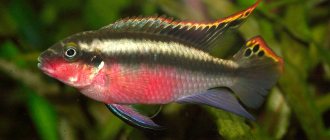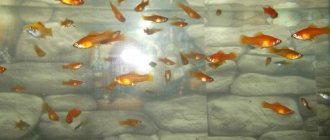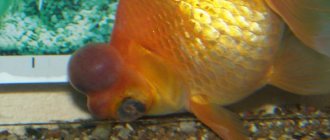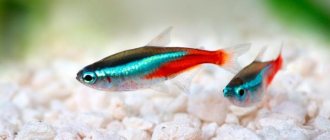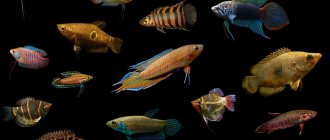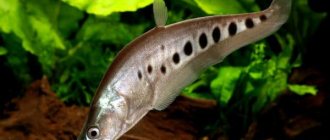Pelvicachromis pulcher (lat. Pelvicachromis pulcher) or as it is also called the parrot cichlid, and most often the aquarium fish parrots are an excellent choice, especially among those aquarists who want to try keeping cichlids in an aquarium.
In addition to their very bright colors, they also have interesting behavior. But the most important thing that attracts aquarists is their small size and peaceful behavior.
They can be kept in small aquariums and are quite unpretentious to water parameters and types of food.
Description of Pelvicachromis
Pelvicachromis is a very colorful fish, easy to care for and falls into the category of dwarf cichlids, which makes them very popular among people who are limited in the size of their aquarium or do not like large fish. Adult males do not exceed 10 cm, and females - no more than 7.5 cm.
One glance is enough to understand why the fish received the name “Parrotfish”. From Latin, the name of the fish is translated as “Pelva” - belly, “chromis” - color and “pulcher” - beautiful (beautiful).
Female Pelvicachromis can be identified by their shortened fins, the presence of a wider yellow stripe at the top of the dorsal fin and a rounded belly that turns bright red/purple during spawning season. Males have longer and thinner fins with distinct dark spots at the end. The color of males is less brilliant, especially the belly.
In general, the fish has a dark, wide stripe from nose to tail. In the rays of light, the scales shimmer with azure lights. The pelvic fins are red. The dorsal and caudal fins are decorated with a yellow border and dark round spots. The intensity of the color often depends on the mood.
Pelvicachromis pulcher is not the only species. Today, you can find various species, natural and selected morphs of pelvicachromis on sale. Here are some of them.
Banded parakeet (Pelvicachromis taeniatus), Boulenger, 1901.
Synonyms: Pelmatochromis kribensis Boulenger, 1911; P. kribensis var. calliptera; P. klugei Meinken, I960; P. kribensis klugei Meinken, 1965.
Variable species, has about 5 color natural morphs:
The male is olive to golden yellow in color, the scales of the upper body are dark-edged, and the abdomen is yellow, bluish to greenish. A dark stripe runs along the body. The dorsal fin is yellow to red, with a red and white border. The anal and pelvic fins are red-blue to dark blue at the base, then purple. The lower half of the caudal fin is streaked with violet-blue, the upper half has 2–4 black dots and a black-red border.
The female has a bluish-purple color of the abdomen, a dorsal fin with 1–2 black spots, a rounded tail with 1–2 black spots in its upper part.
Body length: 9 cm.
Water parameters in the aquarium: t 20 – 25 C; pH 5.4 – 7.5; dH 3 – 20.
Food: omnivore.
Habitat: Nigeria (Niger River Delta), Cameroon.
Natural habitat
In the wild, Pelvicachromis pulchera lives in small bodies of water with dense vegetation in eastern Nigeria, Western Cameroon and Eastern Benin. A fish of a calm disposition that prefers quiet, stagnant, fresh water. The parrot will not experience discomfort from slightly brackish water, since it is distinguished by its endurance and unpretentiousness.
In the wild, Pelvikachromis pulcher feeds on detritus and worms, but does not disdain caviar and the larvae of other fish. Periodically nibbles leaves of green plants. Representatives of Pelvicachromis pulchera, presented in pet stores, are raised by private aquarists or on fish farms. And individuals caught from natural bodies of water are not suitable for import for further sale to aquarists.
Yellow-bellied pelvicachromis humilis, Boulenger, 1916
The male is beige-gray with yellow gill covers and belly, 7–8 brown stripes across the body and red edging along the unpaired fins.
The female has a crimson belly, turquoise gills and a border along the top of the tail.
Body length: 13 cm.
Water parameters in the aquarium: t 24 – 27 C; pH 5.0 – 7.5; dH 0 – 12.
Food: omnivore.
Habitat: Southeast Guinea, Liberia, Sierra Leone.
Pelvicachromis aureocephalus, Meinken, 1960
Males are yellowish, the head and gill covers are greenish-golden, and a blackish stripe stretches from the eyes to the tail. The dorsal fin at the base is dark yellow-olive with a metallic gloss, dark red strokes in the direction of the fin rays, the back half of the fin is intensely red. The anal fin is pale purple, the ventral fins are light blue, the tail has 4 black spots and a red border.
The head and gill covers of females are glossy golden, the abdomen with a red-violet spot.
Body length: 10 cm.
Water parameters in the aquarium: t 24 – 27 C; pH 5.0 – 7.5; dH 0 – 12.
Food: omnivore.
Habitat: Nigeria.
The difference between a male and a female
Many aquarists are faced with the problem that in the species Pelvikachromis pulcher the male and female are similar, therefore, how to distinguish individuals at home?
The difference is that in individuals of Pelvicachromis pulcher the male is larger than the female. The male reaches 10 cm in length, while the female grows up to 7 cm. At the same time, the male develops pointed dorsal, caudal and anal fins. Females typically have purple or red bellies when spawning, and their bodies are more rounded than males.
Pelvicachromis camerunensis, 1962
Imported as Pelvicachromis pulcher, but has a more intense color. During the spawning period, males have a blood-red abdomen, chest and gill covers up to the lips. The lower part of the tail is yellowish. A dark stripe runs along the body; in the upper part of the body there are 3 light transverse stripes. The pelvic fins are red, with a blue edge in the male.
They mature at 9–12 months. Life expectancy in an aquarium is up to 8 years.
Body length: 10 cm.
Water parameters in the aquarium: t 22 – 26 C; pH 6.0 – 7.8; dH 6 – 20.
Food: omnivore.
Habitat: forest reservoirs of Southern Nigeria.
Possible problems
The fish are quite unpretentious and resistant to various diseases. Pelvicachromis does not have any typical pronounced diseases, however, improper keeping conditions can lead to certain problems that are typical for most fish species. Factors causing deterioration in health:
- monotonous food;
- overcrowding of the aquarium;
- lack of hygiene;
- stress caused by external factors - bright lighting or loud sounds;
- sudden changes in water chemical parameters.
If a sick individual is detected, it is necessary to immediately transplant it into a separate container and carry out appropriate treatment. With proper and careful care, the life expectancy of parrot cichlids in artificial conditions is about 5 years.
Roloff's parakeet (Pelvicachromis roloffi), Thys van den Audenaerde, 1968
The male is light purple, the back is gray-brown, and the belly is light. Depending on the condition of the fish, a dark stripe may run along the body. The unpaired fins are yellow-brown, the dorsal with numerous dark spots, the anal with a dark edge, the tail with a dark spot.
The female is grayish-brown with a purple tint, her abdomen is crimson. The unpaired fins are orange, the tail has 3-4 black dots with a white border. The pelvic fins are dark.
Life expectancy in an aquarium is up to 4 years.
Body length: 9 cm.
Water parameters in the aquarium: t 24 – 27 C; pH 5.0 – 7.5; dH 0 – 12.
Food: omnivore.
Habitat: Sierra Leone, eastern Guinea, Liberia.
Reticulated pelmatochromis (Pelvicachromis subocellatus), Gunther, 1871
The male is grayish-yellow with a dark mesh on the body. The pectoral fins are yellowish, the pelvic fins are black. The upper part of the caudal fin has a red border. The dorsal fin and the lower part of the caudal fin are red. Each scale is edged with red.
The female is smaller, plumper, has a yellowish color, unpaired fins with golden streaks. The abdomen and ventral fins are wine red. The fry is yellow-brown.
Body length: 10 cm.
Water parameters in the aquarium: t 23 – 27 C; pH 6.5 – 7.5; dH 5 – 20.
Food: omnivore.
Habitat: Western Africa, from Gabon to the mouth of the Congo.
Diseases
Fish rarely get sick, only if environmental conditions are unfavorable, the water is dirty or the feeding regime is disrupted. The most common illnesses include the following:
- Oodinosis (formation of a yellow film on the body of cichlazoma). For treatment, consult a specialist.
- Obesity. For treatment, review the cichlids' diet and diet.
- Ichthyophthiriasis (white crusts on the body of the fish). For treatment, use copper preparations and change the aquarium water.
- Tuberculosis (the individual becomes lethargic and sinks to the bottom). Treatment with kanamycin is possible, however, it is better to consult a specialist.
Albino morph of Pelvicachromis
Owners of albinos note the following feature - naturally colored males prefer albino females for mating, and all females prefer naturally colored males. Experts believe that the red belly, which is present in females ready to breed, acts as a magnet for males and appears better on albino females.
Conditions for keeping pelvicachromis
Pelvicachromis are completely unpretentious. They come from Africa, where the composition of the water can vary significantly. So the water in the lowlands is dark in color, acidic and very soft, while in the Niger Delta, for example, it is slightly brackish, more alkaline and much harder than in the streams that feed it.
In this regard, in order to most accurately determine the parameters of acidity and water hardness for the fish you purchased, you need to check with the seller the parameters of the water in the aquarium in which they were raised.
When keeping pelvicachromis, it is necessary to use sand or fine gravel of a dark color up to 3 mm and fill the aquarium with it to 3.5 - 5 cm.
The minimum volume is 50 liters, recommended from 80 and more. The size of the aquarium is very important especially when breeding and growing. We need shelter - caves.
As a material for creating caves, you can use stones of suitable shape, glued together with silicone or onto filters and super glue, like this.
The cave should be small, have only one entrance with minimal light transmission. As an alternative material, you can use clay or ceramic pots that do not contain chemicals and have smooth edges, as well as plastic tubes, coconut shells, and driftwood. When using PVC pipes, you need to cut a long piece and fix it in the substrate. And when using coconut shells, you need to break off a small piece of the shell - making an entrance, and put the shell sideways and press it to the substrate.
The presence of living plants will be useful and will serve as a good shelter, but it is worth keeping in mind that fish can dig up the roots of plants. You can easily use plastic aquarium plants , for example, often in pet stores, you can be surprised by plants from the Laguna company , which are perfect for decorating an aquarium with large cichlids.
Do not forget about regular weekly changes of 25 - 30% of the water, especially with dense planting. Filtration and aeration are required. The most important thing is that there are no excessive concentrations of nitrogen compounds and phosphates . This is the main problem for fish that beginners make. Ammonia, nitrite, nitrate, phosphates are the root cause of illness and death in pets. Every conscientious aquarist should always have a set of drop tests on hand, at least for nitrate and phosphate. Fortunately, they have now become inexpensive, there are no problems with their assortment and acquisition. For example, we can with a clear conscience recommend you the cool UHE drop tests, , but they are sold only online. In stores in your city - offline, you can find inexpensive Vladox tests .
When changing water, it would be useful to use clean water supply and use preparations that neutralize harmful substances. For example, Tetra AquaSafe - it removes chlorine compounds, heavy metals + contains B vitamins, iodine and other aquarium goodies. Those. With it, you can safely pour water into the aquarium without fear of harming your beloved pets.
Please note that a sharp change in the chemical parameters of water causes stress in fish, which in turn becomes one of the main pathogens of diseases.
Notes
One of the most common and popular species of cichlids in the aquarium hobby.
Pelvikachromis pulcher (P. pulcher) the best option for beginners
This fish is one of the best options for beginners to both cichlids and fish keeping, it is a reasonable size, fun to watch, beautiful to look at and easy to breed. They have been a favorite since their introduction to the aquarium hobby in the 1950s, and their popularity is guaranteed for many years to come.
Compatibility of Pelvicachromis
If you are going to keep pelvicachromis in a common aquarium, then choose your neighbors wisely, they should be peaceful and quite nimble, and the main thing is not to occupy the caves of pelvics, which should be in abundance for everyone. As neighbors we can recommend characins, barbs, zebrafish, rasboras, corydoras, gouramis, and various types of cichlids native to West Africa.
You certainly shouldn’t keep ancistrus and other loricariids with pelviks, which, like pelviks, love to dive and spawn in caches: twigs, coconuts and pots.
Like all cichlids, pelvicachromis are fast swimmers and can be aggressive, especially during the spawning period. Avoid overcrowding the aquarium.
Character of aquarium parrots
Pelvikachromis pulcher is a type of aquarium fish that is endowed with a fairly calm character, but it is also impossible to say that they are so peaceful. These small fish will not attack their neighbors in the aquarium only until a certain time, until they have to defend their territory.
Parrots are owners, and they do not tolerate encroachments on their part of the aquarium bottom. Females can show aggression to a greater extent than males, with the exception of the period when they are guarding a shelter with eggs. Then the males become extremely unfriendly towards other aquarium inhabitants.
They are not particularly fond of slow fish that move smoothly and leisurely around the aquarium. Parrots are nimble and very fast fish; if they see an obstacle in front of them in the form of another aquarium inhabitant moving smoothly, they will hurry it up in an interesting way - by gnawing on their tail.
What to feed Pelvikachromis
It is not very difficult to please parrotfish in food. At the same time, a varied diet is the key to the health of your fish. Keep in mind: in nature, fish swim mainly near the bottom, so it would be a good idea to use sinking types of food. We recommend using high-quality food from Tetra.
It should be noted that when purchasing any dry food, you should pay attention to the date of its manufacture and shelf life, try not to buy food in bulk, and also store the food in a closed state - this will help to avoid the development of pathogenic flora in it.
How to preserve the natural color of fish
First of all, add shell-less shrimp and specialized food for this type of fish to your diet. It contains a natural dye that will maintain the intensity of the pigment.
Additives in the form of living greens will also bring results: sweet peppers, peas, zucchini. A dark background will emphasize the brightness because the fish has a protective color. As the temperature drops, the color becomes pale.
Breeding and propagation of Pelvicachromis
If you are planning to breed Pelvikachromis, then it is best to look for an already formed pair. However, you can also choose a pair from the fish you like in the store; Pelmatochromis form pairs quite well. They create pairs for life - there is no point in separating them. It is interesting that females of pelvicachromis are, as a rule, brighter in color than males. Female parrots (unlike most other cichlids - and most fish in general) are the "active party" in courtship. It is the females of Pelvikachromis that “seduce” the males, fight for them, choose and clean the nest...
Breeders noticed a very interesting feature - at pH 7.0, pelvicachromis produce offspring of approximately equal sex ratio. And soft, acidic water tends to produce more females, while more alkaline water tips the scales toward producing more males.
Pelvicachromis reach sexual maturity at 6 months (females mature earlier than males). During spawning and courtship for fry, the fish become very aggressive. During the mating season, the fish are generously fed with live food. The color of the fish will become more intense as they are ready to mate. In most cases, females will proactively show bright belly color. At this moment, females are the most aggressive. Pairs can often be seen moving soil out of the cave shortly before spawning, preparing the cave for their young. Once the pair has prepared their nest, spawning begins. The female can lay 200 to 300 eggs at a time. From the moment the clutch appears until the free-swimming fry appear, the female will remain in the cave, coming out only to quickly feed. At this time, the male patrols the property near the cave, protecting the female and offspring.
Caring for the fry is not very difficult. When the fry are kept at a temperature of 29 0C, the fish begin to swim freely within a week. At this moment, barely visible fry can be observed on the surface of the ground. When leaving the cave, they stay close to their parents. In some cases, one parent will care for the offspring while keeping the other away. The fry should be fed with freshly hatched brine shrimp, ground dry food, or special commercial food for fry several times a day.
During this period, it is necessary to do frequent water changes, taking into account the constant feeding of the fish. If this is not done, then poisons - ammonia, nitrites and nitrates can destroy the younger generation. After 2 - 4 weeks, the fry will be approximately a little over a centimeter in size and can be safely separated from their parents. By two months, the dotted pattern on the body of the fry is replaced by horizontal black stripes. The habits and colors of adults and fry acquire by 4 months.
Author Alexander Isakov
Editor V. Chernyavsky
O. Matsevich
Incubator
If Pelvicachromis pulchers are kept for the purpose of active breeding, frequent spawning can be encouraged by moving the eggs after the female lays them into an incubator. The pot, on the walls of which the eggs were laid, is very carefully transferred to another tank, where a sprayer is placed near the shelter with the eggs.
The incubator must contain clean water with a temperature of at least 29°C. The incubation period and further development of the fry occurs in the same way as in the presence of parents. A pair of fish left in the aquarium without eggs will mature faster for a new spawning. Feeding the fry in the incubator begins from the moment they swim.
